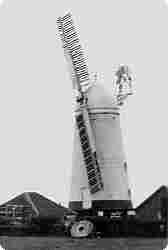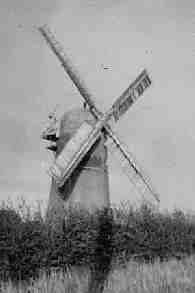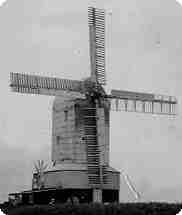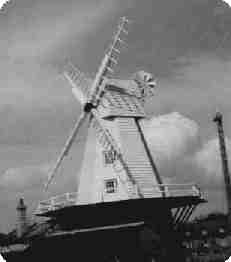|
TRADITIONAL WINDMILLS: ENGLAND, HOLLAND and the USA
WINDMILL
LINKS WIND
TURBINES
Europe
was the heart of Windmill development and fortunately many
fine examples are preserved, some, especially in Holland
where Windmills are present in large numbers in a small
area. Even more remarkable is the fact that many
of these windmills are in very reasonable, many of them
even in excellent, condition and a considerable number
of them are working regularly. Moreover, there are
windmills of the many varied types: drainage mills, corn
mills, and industrial mills for all sorts of purposes.

Stones
Cross - East Sussex
Standing
tall against the horizon, their sails whirling in the
air, the windmill has often captured man's fancy. From Cervantes
who wrote of Don Quixote's famous attack on the windmill
giants to the paintings of the East Anglian countryside
of John
Constable, whose family owned mills, the windmill
has played a part in the historic and artistic, as well
as economic, development of western civilization.
Holland comes to mind first as the windmill capital of
the world, but England's windmills were equally
plentiful and important to the economy of the country.
Windmills
have had a long and varied history since their
development in Europe in the twelfth century. There is
speculation that windmills may have existed in Europe at
the time of the First
Crusade in 1096, however, the earliest written
record of a windmill's existence in England is a rental
note for a mill in Weedly, Yorkshire dated 1185. It
wasn't until 1270 that an illustration of a windmill
appeared and that was found in the Windmill Psalter
which had its origin in Canterbury.
The Domesday
Book makes no mention of windmills, but there
are records of a mill in Bury St. Edmunds built in 1191
in defiance of the local abbot who forbid its
construction. Consequently, it was destroyed.

Patchham
- East Sussex
The
windmill was designed to replace animal power in the
grinding of grain--usually wheat or corn. A mill could
grind up to 1,000 bushels of grain a week, six bushels
per hour if the wind was steady. The popularity of this
energy source spread throughout the ensuing centuries
until in 1400 there were 10,000 windmills in England,
mostly in the South and the East where massive wheat
fields are located, particularly in East Anglia, Kent,
and Sussex. Once windmills were located in London as
well, but the only evidence of their existence that
remains today may be found in street names such as Great
Windmill Street and Millbank.
During
the medieval period, mills were governed by
"milling soke"-- part of each manor's charter.
The mill was the property of the the lord of the manor
who, as a result, had a monoploy over milling no matter
who originally built the mill. It was, however, the
manor lord's responsibility to have enough mills to meet
the needs of his people and to handle major repairs on
the mills. The church was also involved in the windmill
business. Pope
Celestine III claimed that the air used by windmills
was owned by the church and that consequently they must
be built with the church's consent and a papal tithe
paid for their operation.
Tenants
on the manor were obliged to grind their corn at the
lord's mill at a fixed rate of toll in kind--usually
1.16 of the corn ground for estate-grown corn. The
lord's corn, of course, was ground free and given
priority. Only if the mill fell into disrepair could
tenants have their corn ground elsewhere.
By the
nineteenth century, the English iron founding industry
improved the mechanical operation of the mills and
influenced mills being built in Europe. At this time,
the windmill was also being used to drain marsh lands
and to pump irrigation water. The nineteenth century was
the high point in the history of the windmill, and they
were commonplace in towns and villages. William Cobbett
of Ipswich commented in 1830:

Cross
in Hand - East Sussex
The
windmills on the hills in the area are so numerous
that I counted whilst standing in one place, no less
than seventeen. They are all painted of washed white,
the sails are black...and their twirling together
added greatlly to the beauty of the scene, which
having the broad and beautiful arm of the sea on the
one hand and the fields and meadow studded with farm
houses on the other appeared to make the most
beautiful sight of th the kind that I ever beheld.
However,
the growth of towns in the late nineteenth century led
to the depopulation of rural area. This coupled with the
establishment of large mills at the seaports and the the
advent of steam power, electricity, and the internal
combustion engine led to the windmill's decline.
During
World War I, millers were forced by government
regulations to grind only animal feed thus liminting
their usefulness. At the end of the war, there were only
350 working mills. By the end of World War II, only 50
working mils remained. After 1945, the shortage of
skilled labor and the higher price and shortage of
materials coupled with the flow of cheap American flour
into Britain sealed the windmill's fate. By 1950, all
mills used for drainage purposes had ceased work and
were replaced by electric power. Since then, the
elements have destroyed many windmills. The post and
smock mills were the most vulnerable because of their
wooden construction. Many brick and stone tower mills
were torn down after World War II because of the need
for these scarce building materials. Some mills were
converted into homes. One, near Reigate, is used as a
church. It has monthly services.
Today
only 90 windmills are still in existence. The first mill
to be restored was the mill on Wimbeldon Common, a
project financed by public subscription and completed in
1883. However, it wasn't until 1965-70 that there was a
real resurgance of interest in the restoration of
windmills. This interest was encouraged by the National
Trust and the Society
for the Protection of Ancient Buildings. Local
councils and societies also participate in the
restoration work. However, restoration is a costly and
maintenance even more so. Consequently, some mills which
were restored during the last several decades have since
fallen once again into disrepair such as the mill at
West Kingsdown, Kent. Very few working mills may be seen
today. Perhaps the renewed interest in wind as an
alternative energy source will further encourage efforts
to preserve this rapidly fading part of the British
national heritage.

Rye
- East Sussex
If
you want to learn more about Windmills in Sussex, Europe
or the USA, tune in soon.
WINDMILL
LINKS WIND
TURBINES

Solar
Cola sponsor this website
|